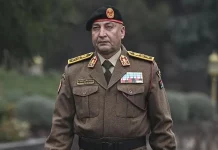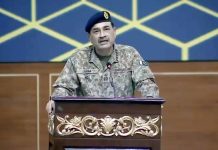
The militant Islamic State group claimed responsibility for the terrorist attack in Quetta which killed 20 people and left 48 more injured.
The group released a photograph of the bomber along with his name on Saturday and said the attack targeted the Shia community. It has claimed a number of attacks in the past.
On Friday, however, a little known faction of the Taliban had claimed responsibility for the blast, saying it collaborated with Lashkar-e-Jhangvi (LeJ), which has been behind numerous bloody attacks on the Shia community in Pakistan.
Hazara community stages sit-in on second consecutive day, demands justice
The Hazara community, including women and children, continued their sit-in in Quetta’s Western Bypass area for the second straight day.
They demanded that the provincial government provide security to the Hazara community and for the perpetrators to be brought to book. “The government has failed to provide us security despite our repeated protests and requests,” Kazim Raza Hazara, one of the protesters, told media .
Traffic remained suspended on the main Western Bypass due to the sit-in.
“We want justice for our community,” Muhammad Juma Hazara said, while Kashif Hussain questioned: “When will this bloodshed stop?”
Balochistan Home Minister Mir Ziaullah Langove, Health Minister Naseebullah Marri, and President Hazara Democratic Party (HDP) Abdul Khaliq Hazara, all met the demonstrators and offered them the provincial government’s assurances but failed to convince them to end their sit-in.
Prime Minister Imran Khan, a day earlier, had condemned “the terrorist attack” and sought “an immediate inquiry and increased security for the [targeted] people”.
Amnesty International, in a statement on Friday, had said the blast was a “painful reminder” of the many attacks suffered by the Hazara community in Quetta over the years.
“Each time, there are promises that more will be done to protect them, and each time those promises have failed to materialise,” wrote Omar Waraich, Amnesty’s deputy director for South Asia.
Following a high-level meeting under Balochistan Chief Minister Jam Kamal’s stewardship on Friday, it was decided that closed-circuit television (CCTV) cameras will be immediately installed at the Hazarganji market and other public places.
Action on terrorists’ hideouts and against their leaders will also be boosted, the caucus affirmed.
Hazarganji a repeat target
The Hazarganji area in Quetta has been witness to similar attacks in the past. Hazara shopkeepers are known to stock vegetables and fruits from the Hazarganji bazaar to sell at their own shops. They are provided a security escort to and from Hazarganji since they are constantly under threat of attack.
DIG Cheema, speaking to media explained that “people from the Hazara community come here daily in a convoy from Hazara Town to buy vegetables. They are escorted by police and Frontier Corps (FC), and then they return there. It was the same today,” he said.
“There were 11 cars and 55 people. Police and FC were in front of them and behind them. They [the security] brought them to Hazarganji. When they entered the sabzi mandi, the police expanded their perimeter to the gates so that no one would enter, while the FC took their positions,” he continued.
“Around 7:30am, they [the shoppers] were loading [produce] at a shop when the blast happened.”
“The security forces are here, police are here. What more can we do? We secure them [the community] and travel back and forth with them. If something is hidden in a shop, then the shopkeepers will need to be probed,” he said.
He explained that the last time there had been an attack in the area, he had written to the administration and asked them to keep the area clean so that there were no hiding places for bombs.
He also regretted that the Safe City project for Quetta had run into delays, and that there was a shortage of CCTV cameras in the area.
The attack came after a lull of at least a year in attacks against Hazaras, though there have been isolated shootings.



